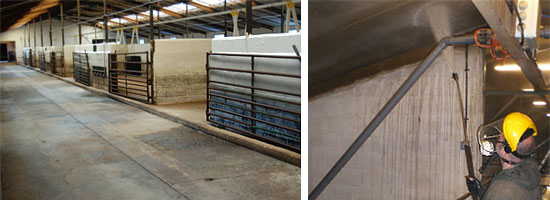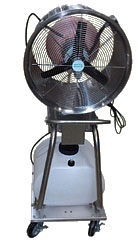In the last article we looked at the need for thorough complete cleaning of a building, room or equipment in any efficient biosecurity programme. If done properly this will reduce the pathogen burden hugely as shown by a typical reduction in bacterial counts by 99%. However the level of potential pathogens remaining after even the best cleaning represent a serious risk to pig health and productivity. This is why it is now necessary to disinfect using a broad spectrum disinfectant. A later article will cover choice of disinfectant, but here we are concerned with applying the disinfectant correctly so as to achieve a maximum reduction in pathogens.
Preparation
Disinfectant can be applied in a number of ways, but this is usually by a knapsack sprayer or pressure washer on a low pressure setting. In very large buildings orchard sprayers have been successfully adapted for this purpose.
Depending on what applicator is used the disinfectant has to be made up either into a stock solution for dilution during application, or at the final required dilution. It is vital in either case to calculate the correct amount of disinfectant to use, and then to ensure thorough mixing. If the water in a given area is particularly hard it may be necessary to adjust the mixing procedure. Also if the disinfectant is to be used in very cold conditions it may be necessary to add antifreeze to the solution. Consider if this affects the disinfectant activity, and if the disinfectant is active at such temperatures. Whatever the circumstances it is best to make up the solution freshly.

Removed Equipment
During cleaning all moveable equipment will have been removed from the room and thoroughly cleaned. Check the area it is in is clean and then disinfect the equipment using sprayer or pressure washer. Start from the top and work downwards ensuring all areas are covered. Small items may be more easily disinfected by submerging in a tank of disinfectant. Once all this has been done these items can be returned to the room taking care not to re-contaminate them.
Water System
In the cleaning procedure the water system should have been thoroughly cleaned, and where appropriate drinkers removed and cleaned. These should now be immersed in a tank of disinfectant and the water system flushed through with disinfectant. The drinkers can now be reconnected. If the disinfectant used is not approved for use in the drinking water of pigs the whole system must be thoroughly flushed with clean water.
House Disinfection
Now it is time to disinfect the house. Make one final check that there are no gross organic materials left and then proceed. Using the sprayer of choice apply the disinfectant solution evenly to all surfaces to achieve thorough wetting (this is achieved much more easily if the disinfectant contains a surfactant) and good contact time. Pay special attention to cracks, corners, ledges and other areas that are difficult to access. Start with the roof and work down the walls and fixed equipment to finish with the floors. Work from one end of the building to the other finishing at the door. All the way through this procedure take care not to reintroduce contamination on dirty boots, overalls or equipment.
Provided by DuPont Disinfectants - www.ahs.dupont.com
It is essential to apply the disinfectant solution at the correct rate. Check that you are doing this by calculating the amount of disinfectant to be applied to a given area and then checking usage to see if it is as calculated. This is a common error and can result in inefficient disinfection or wastage of product.

It is essential that correct health and safety procedures and personal protective equipment are used during the application of disinfectants. Managers and operatives must read and familiarise themselves with product datasheets and ensure they are complied with.

Aerial Disinfection
However good the disinfectant programme is there is still a danger that inaccessible areas may not have been reached, and also that organisms could have been introduced into the house during the procedure. To counter this it is advisable to finish with some form of aerial disinfection which can either be achieved by thermal fogging, cold fogging or fine mist spraying. Again some products require stringent health and safety precautions, whereas others can be more safely used.
Finishing off
Once the above is completed the house should be allowed to dry before reintroducing pigs. Time can be a limiting factor for this and auxiliary heaters will help. During this period it is important not to allow reintroduction of pathogens and one way to help this is by putting a disinfectant foot-dip outside the room.
Some procedures will use dry disinfectants on the floor at this stage. While their disinfectant activity is not generally high they do have a long contact times and help dryness, both of which can be a benefit.
Finally remember that anything introduced into the room after this is a potential contaminant. Pay special attention to any bedding used, any equipment returned to the room, and finally, in the case of farrowing rooms consider washing and disinfecting the sows before they enter.



